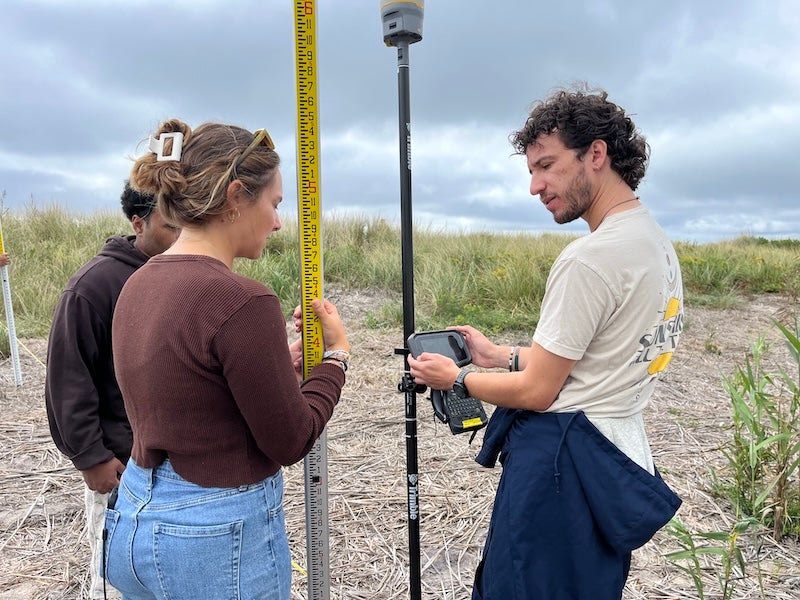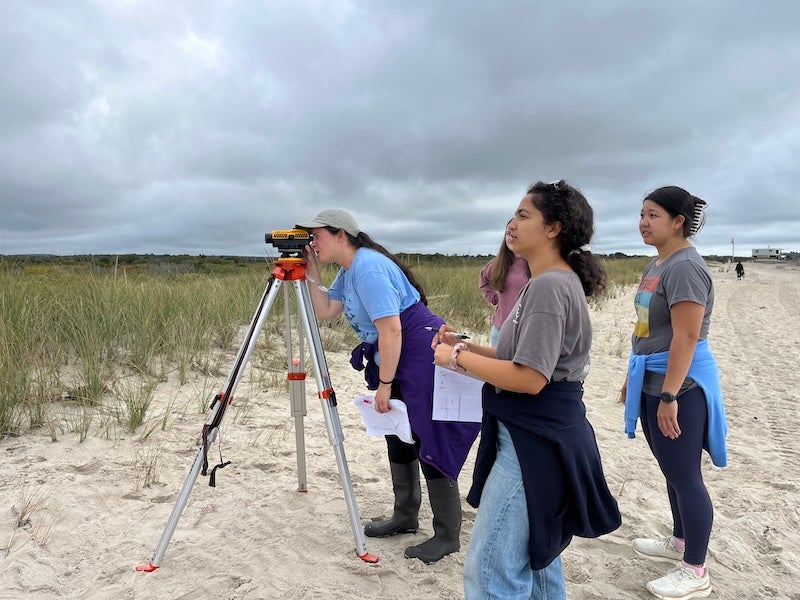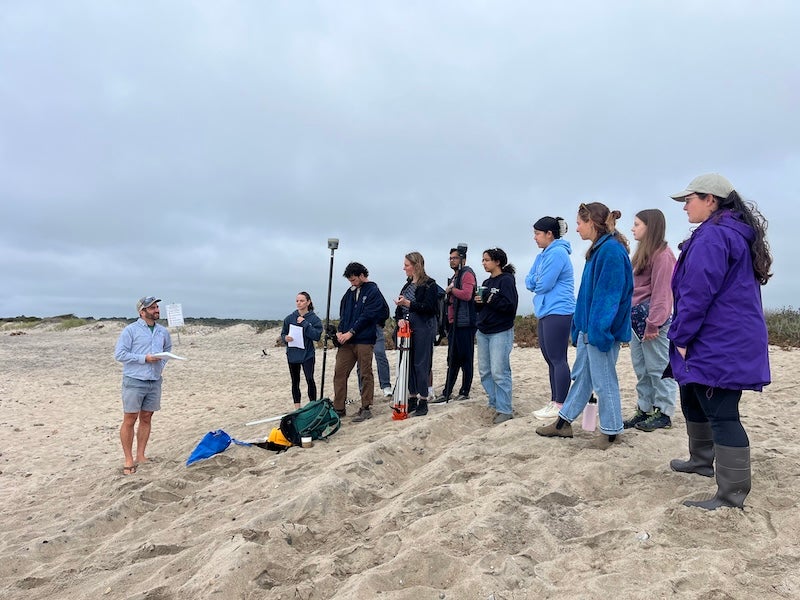For many Rhode Islanders, coastal hazards are a facet of daily life. Climate change, rising sea levels, and groundwater depletion mean that residents of the Ocean State are experiencing coastal flooding, beach erosion, and groundwater salinization more and more often. In a new course, Coastal Geologic Hazards (GEO 557), Assistant Professor of Geosciences Christopher Russoniello is preparing the next generation of scientists, policymakers, and engineers to better understand and respond to these challenges.
Originally developed by Professor Simon Engelhart as one of the core courses for URI’s Graduate Certificate in Coastal Resilience, Russoniello has adapted Coastal Geologic Hazards to further emphasize interdisciplinary, student-led, and hands-on learning. The main goal of the class is to develop students’ understanding of the processes that shape coastal environments and the hazards they face. Throughout the semester, students engage with the topic of coastal vulnerability by studying tides, waves, erosion, sea level rise, and storm impacts, as well as human interventions. Russoniello intends for the course to prepare students for careers in coastal and environmental science, resource management, consulting, or graduate study, while fostering the ability to evaluate and address the challenges of coastal hazards in our changing climate.
An Interdisciplinary Approach
Just as the coast is a confluence of different environments, industries, and communities, the class has drawn students from various academic disciplines. “Everyone is coming into this course from a very different background,” Russoniello says. This is a strength, he underscores, “because we all have different ideas of what a hazard is at the coast depending on what our experience is.” With these different perspectives, students will gain a well-rounded understanding of coastal hazards. Russoniello plans to capitalize on his students’ diverse backgrounds by allowing them to shape the class around their areas of interest. Over the course of the semester, each student will lead a discussion on a paper of their choice relating to coastal hazards. “I am hoping to learn as much from my students as they learn from me,” says Russoniello. “I’m excited for them to also be putting their imprint on the class.”
Russoniello has a number of guest lectures on the schedule to further enhance the cross-disciplinary study of coastal hazards. The first will be given by Mehrshad Amini, assistant professor of civil, environmental, and ocean engineering at URI. Later in the semester, Russoniello hopes to bring in social scientists to discuss the impacts of coastal hazards on the well-being of communities.

Hands-On Learning
To tie concepts learned in class to real-world scenarios, Russoniello has several field trips planned. The first field trip to Moonstone Beach, for example, demonstrated how beach profile changes over time. Students discussed impacts of storms and sea level rise, and gained hands-on experience mapping beach profiles. Using auto levels and high-precision GPS instruments, students took elevation measurements across a transect, which ran from the shore, up over the dunes, and back down to the salt marsh behind the dunes. This exercise gave the class a snapshot of the work done by URI’s COAST Lab, which has been monitoring the morphology of Moonstone Beach using similar methods since the 1960s. By comparing these elevation profiles over time, the COAST Lab is able to visualize how rising sea levels and intense storms are changing the shape and location of the shore and dunes.
Later in the semester, students will visit Fox Hill Marsh to take sediment cores that will allow them to see evidence of historical floods: a layer of sand in otherwise muddy, peaty soil. The class will also visit the East Bay town of Warren to better understand how flooding is impacting urban communities.
Geosciences at the Core
A physical hydrogeologist, Russoniello joined URI’s Department of Geosciences in 2022. He has spent his academic career studying the movement of water from a variety of angles, ranging from beaver dams to thawing permafrost. These days, Russoniello’s research interests revolve around the salinization of freshwater resources, such as groundwater. The increase of salt in groundwater can happen from both natural processes (such as rock weathering and saltwater intrusion from the ocean) and human activities (like over-pumping of groundwater and salting roads). Russoniello specifically investigates how waves, tides, and sea level rise are impacting our groundwater drinking supplies in the context of climate change.

In URI’s Department of Geosciences, students, faculty, and staff understand that “all of our major environmental problems—clean water shortages, global warming and sea level rise, land use, natural hazards, environmental pollution, stormwater remediation, and the availability of key natural resources—find their scientific roots, and their ultimate solutions, within the study of earth, water and climate sciences.” With Coastal Geologic Hazards joining URI’s course catalog this fall, the Department of Geosciences offers students yet another opportunity to deeply understand a pressing issue of our time. Such major environmental problems can feel daunting, but as Russoniello says, “if we have folks that have more information, more training on this, they’ll help the state adapt as the climate changes and seas rise… we’re a resilient group of folks here.”
Story and photos by Jessica Minker, CELS Communications Fellow

